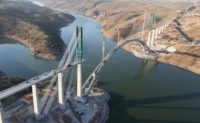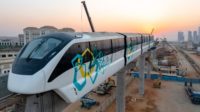Indian engineers are preparing to slide a bridge deck across a remote Himalayan valley aiming to complete the world's highest arch railroad crossing in 2023. Difficult terrain, harsh weather and the threat of terrorism extended construction of the Chenab River bridge to nearly two decades.
So inaccessible was the valley in India—administered Jammu and Kashmir—that engineers preparing to bid for the contract had to travel on horseback. In 2004, construction was expected to last about three years, but the project reached its peak only this April when the last steelwork section completed the arch. Prime minister Narendra Modi hailed the event as marking India’s growing engineering prowess.
The bridge is one of the last major elements of the new 272-kilometer Udhampur-Srinagar-Baramulla Railroad that will connect the Kashmir Valley with India's national network at a point north of the city of Jammu. Started more than 20 years ago, the USBR includes around 900 bridges of various types and more than 110 km of tunnels.
Located about 100 km north of Jammu, the 467-m-long Chenab arch straddles the steep valley some 359 m above the river bed. Steel lattice piers up to about 131 m tall will be erected on the arch at generally 48 m intervals to support the bridge's steel box girder deck, soon to be slid into place.
Government-owned Konkan Railway Corporation Ltd. (KRC) is handling the Chenab project for the railroad's owner, Northern Railways. With much of the Udhampur-Srinagar-Baramulla route completed, Northern assigned most of the last 111 km between Katra and Bannihal to KRC and to the government's Ircon International Ltd.
KRC in turn subcontracted the bridge's design/build contract to Chenab Bridge Project Undertaking (CBPU) in 2004 for about $72 million, according to a project source. India’s railroad ministry now values the bridge at about $200 million. The contract also includes five spans on the river bank side slopes and a conventional 11-span northern viaduct.
Led by Afcons Infrastructure Ltd., CBPU formally included South Korea's ULTRA Construction & Engineering Co., Ltd. (now operating as Hoban Industrial Co., Ltd.) and VSL India. However, ULTRA and VSL are effectively "sleeping partners," says a senior project engineer, asking not to be named.
For overall design, CBPU hired the small Finnish firm ConsultingKORTES Ltd., which has since been acquired by WSP Group. Germany’s Leonhardt, Andrä and Partner became the subconsultant handling the bridge's detail and erection designs. Required by Konkan to use bridge information modeling, WSP adopted Finland-based Tekla Structures.
Strong winds, seismic forces
Located in an area of strong winds and in one of India’s most onerous seismic zones, the structure’s dynamic behavior called for intensive modeling. "Big discussions" about how much lateral movement included references to designs in China, says Pekka Pulkkinen, WSP's design director.
To understand local wind dynamics, the designers first had a model of surrounding hills and valleys tested in by Force Technology in Denmark. Standard wind tunnel tests on a bridge models followed for a maximum design speed of 266 km per hour, according to KRC.
Unusually, the designers had also to consider structural survivability in case of terrorist acts, which are feared in the territorial dispute with neighboring Pakistan. With advice from India's Defense Research and Development Organization, the design aims to allow for the loss of major structural elements without collapse, says the senior engineer.
While engineers grappled with designs, site staff had to establish fabrication facilities on either river bank, says the engineer. The tortuous mountain roads had ruled out deliveries of large prefabricated components. So virtually all the steelwork was fabricated on site from around 30,000 tonnes of plates for the whole crossing, he adds.
To reduce wind resistance, the original structure was to be fabricated in steel tubes. But because of doubts over the quality of welding on site, the design was changed to steel boxes soon after the contract was signed.
Containing more than 10,500 tonnes of steelwork, the arch comprises four curved, 9-m-deep cross-linked trusses set in two pairs side by side. Top and bottom chords of the trusses are formed by 70-cm-wide x 90-cm-deep steel boxes which are linked by box girder webs. In each pair, the trusses are fixed 2.6 m apart by horizontal and cross girders. The arch structure narrows from over 30 m wide at the abutments to around 10 m at the crown.
Erection jitters
At first, the plan was to use rolling derricks to erect the arch, piers and deck simultaneously as cantilevers from either bank. But, experiencing "a lot of jitters" about that risky strategy, the team went for a sequential approach instead, says the engineer.
The contractor assembled the arch in bolted sections, cantilevering from both sides. As the cantilevers grew longer, they were tied back with cables passing over the pre-installed lattice towers at the abutments and down to ground anchorages on either river bank.
Arch sections travelled to their final positions along four cables strung between all steelwork towers about 130 m tall and set nearly 1 km apart on either side of the river. Each cable crane can handle elements weighing up to 36 tonnes at a time, says the engineer.
With the arch in place, its chords are now due to be filled with concrete to improve wind stability. With that done, the remaining lattice towers will be erected on the arch. Then their tops will be tied together to prevent excessive deflections when the bridge deck is launched over them from either river bank starting this September and planned to end in April.
While project teams were jubilant at the arch closing this April, they acknowledge the greatly extended project schedule. The senior engineer lists harsh weather, hard terrain and suspicion of hostile residents of local communities in the politically tense region as some of the key challenges.
Added to these was the need for "very big earthworks because the [valley] slopes had to be stabilized against earthquakes," says WSP's Pulkkinen. More than a million tonnes of earthmoving and countless rock bolts were needed to cut and stabilize steps in the valley slopes.
And despite the site's remoteness, the coronavirus impacted the project. In the pandemic's first phase last year, less than half of planned activities were conducted. Downtime was compounded by nationwide supply disruptions which added six months or so the project's already long gestation.
The contractor has vaccinated all workers and around 500 local inhabitants at no cost, says a spokesperson.










Post a comment to this article
Report Abusive Comment